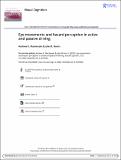Eye movements and hazard perception in active and passive driving
Abstract
Differences in eye movement patterns are often found when comparing passive viewing paradigms to actively engaging in everyday tasks. Arguably, investigations into visuomotor control should therefore be most useful when conducted in settings that incorporate the intrinsic link between vision and action. We present a study that compares oculomotor behaviour and hazard reaction times across a simulated driving task and a comparable, but passive, video-based hazard perception task. We found that participants scanned the road less during the active driving task and fixated closer to the front of the vehicle. Participants were also slower to detect the hazards in the driving task. Our results suggest that the interactivity of simulated driving places increased demand upon the visual and attention systems than simply viewing driving movies. We offer insights into why these differences occur and explore the possible implications of such findings within the wider context of driver training and assessment.
Citation
MacKenzie , A K & Harris , J 2015 , ' Eye movements and hazard perception in active and passive driving ' , Visual Cognition , vol. In press . https://doi.org/10.1080/13506285.2015.1079583
Publication
Visual Cognition
Status
Peer reviewed
ISSN
1350-6285Type
Journal article
Description
This work was supported by the Engineering and the Physical Sciences Research Council (EPSRC) under Grant EP/K503162/1.Collections
Items in the St Andrews Research Repository are protected by copyright, with all rights reserved, unless otherwise indicated.

